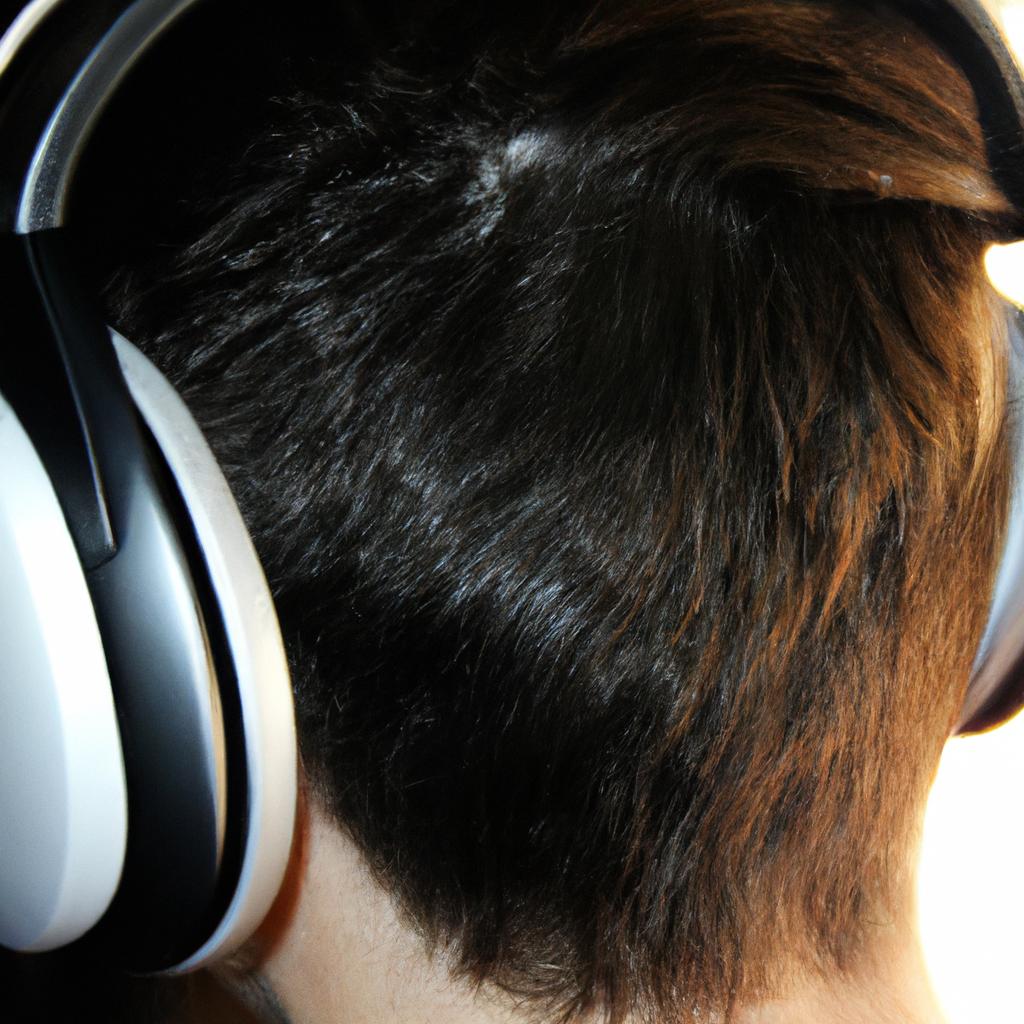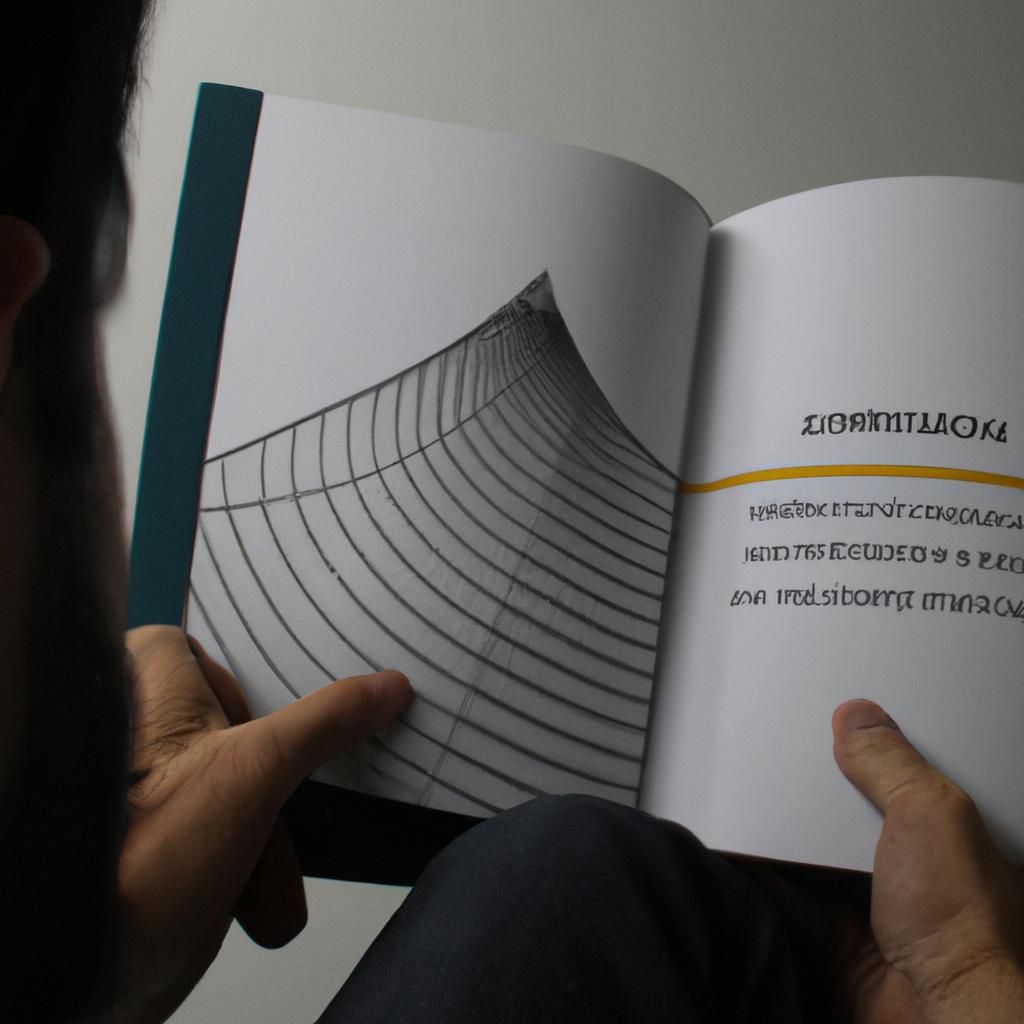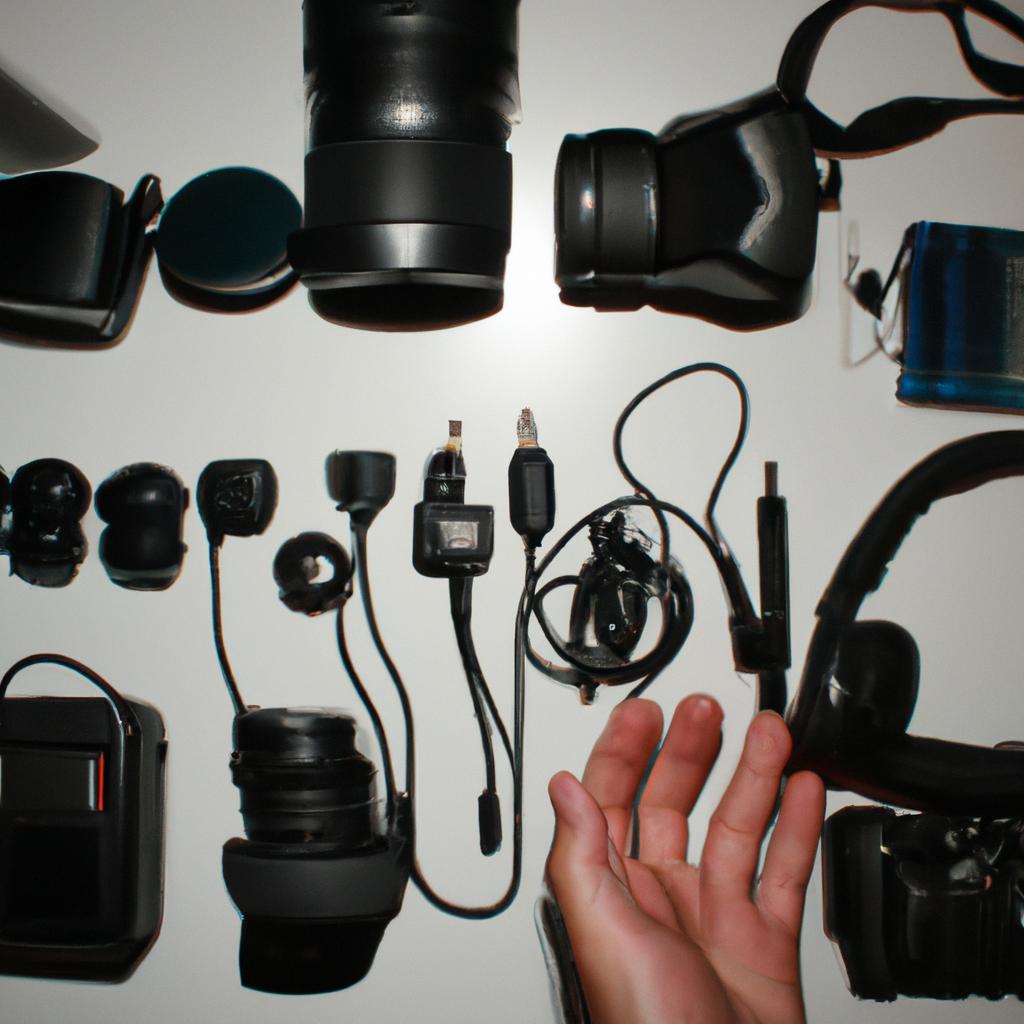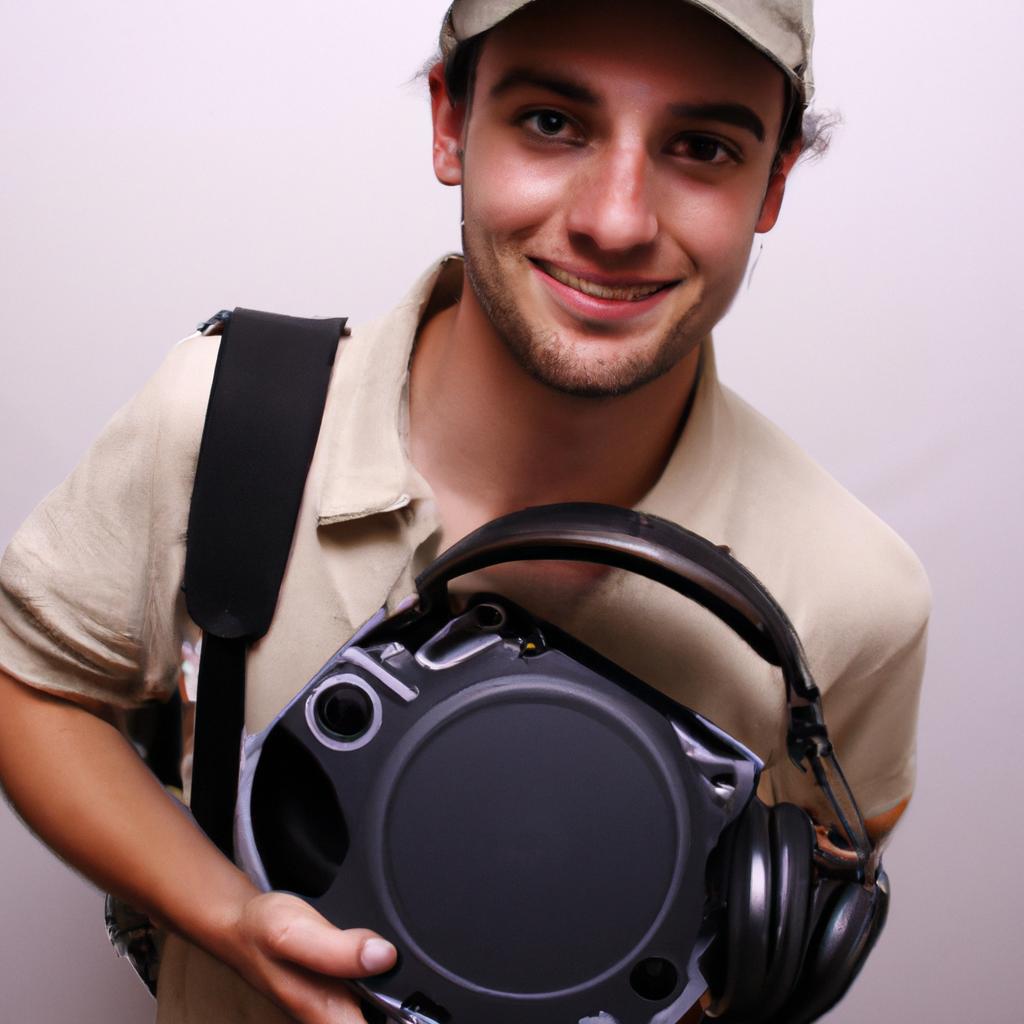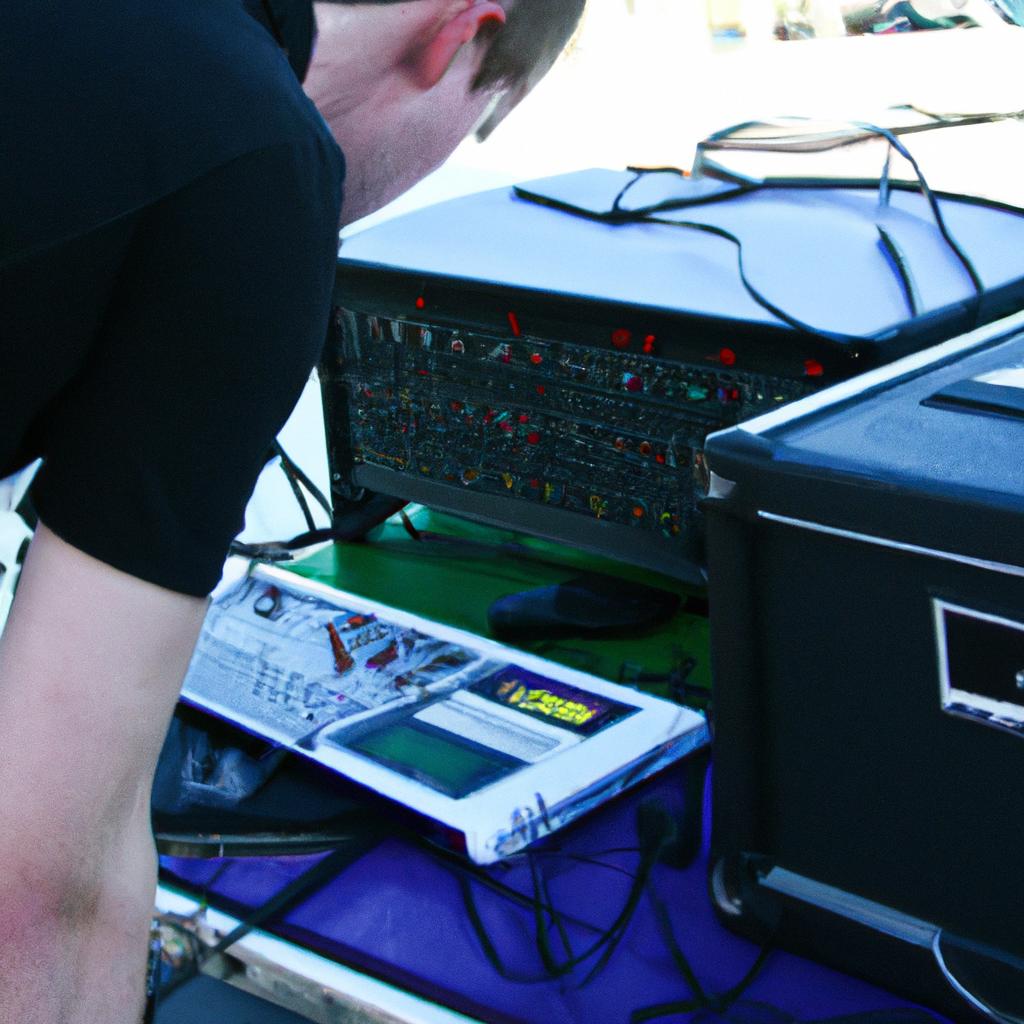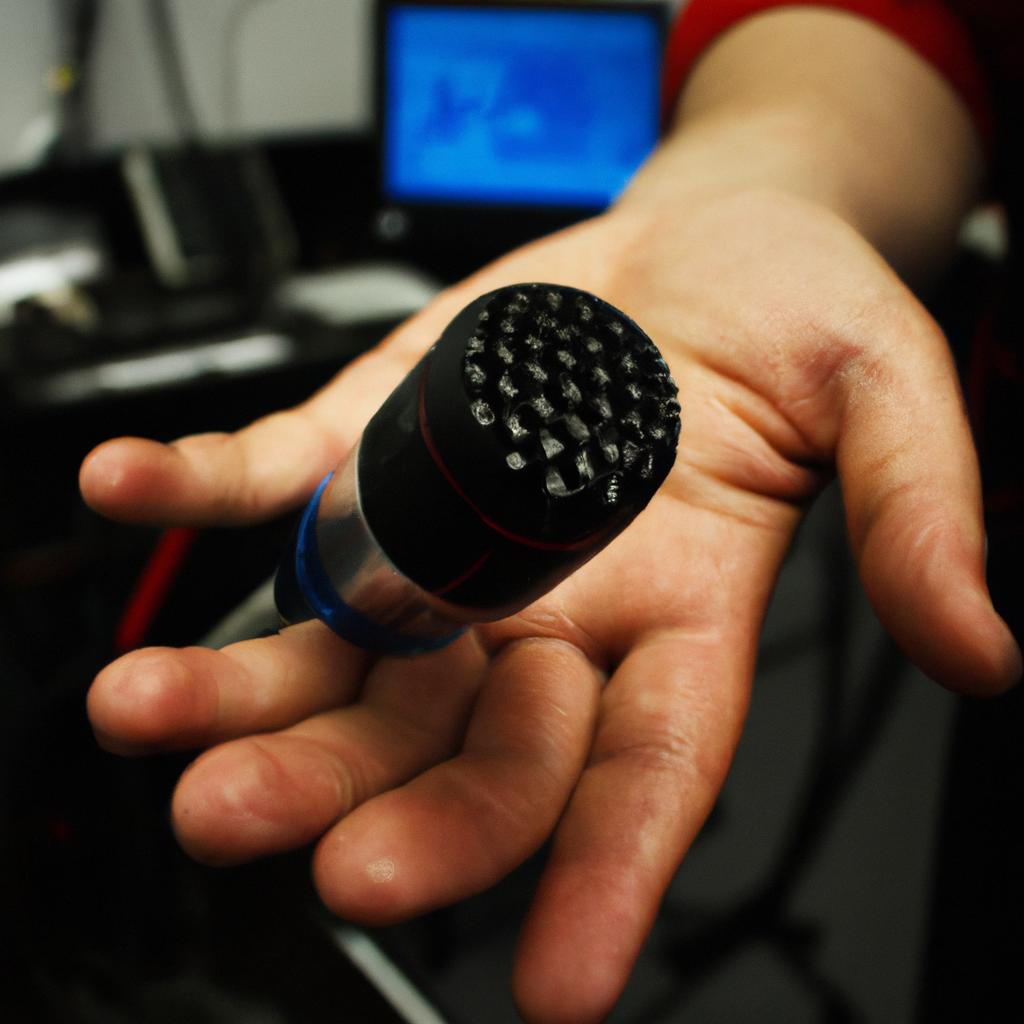Audio equalization methods have played a critical role in shaping the quality and clarity of sound, enabling listeners to experience immersive auditory experiences. In recent years, the advancements in technology have not only enhanced audio reproduction but also expanded its applications across various industries such as music production, broadcasting, film-making, and virtual reality. For instance, imagine a hypothetical scenario where a renowned music producer is working on a new album for an up-and-coming artist. The producer aims to create a unique sonic landscape by applying different audio equalization techniques to shape the sound frequencies and tonal balance of each instrument.
Furthermore, audio equalization methods are not limited to enhancing sound; they also extend into the realm of visual perception. Through synesthetic effects, these methods can enhance the overall sensory experience by creating a harmonious connection between sound and vision. This integration allows for more dynamic multimedia presentations where visuals are synchronized with specific frequencies or tonal qualities of the accompanying soundtrack. For example, consider a case study involving a virtual reality gaming experience where players navigate through different environments while wearing headphones that use audio equalization techniques to heighten immersion. As the player moves from one scene to another, subtle variations in EQ settings correspondingly alter both the soundscape and visual elements within the virtual world , creating a seamless and immersive experience for the player. This integration of audio equalization techniques with visual elements adds another layer of depth and realism to the virtual reality environment, allowing players to feel more connected to the virtual world they are exploring.
In addition to music production and virtual reality, audio equalization methods have also found applications in other industries such as broadcasting and film-making. In broadcasting, EQ techniques are used to ensure clear and balanced sound during live events or recorded programs. By adjusting the EQ settings, broadcasters can enhance speech intelligibility, reduce background noise, and create a more enjoyable listening experience for viewers.
Similarly, in film-making, audio equalization plays a crucial role in post-production to achieve desired sound effects and emotional impact. For example, EQ can be used to emphasize certain frequencies in dialogue scenes or add depth and richness to the soundtrack of an action sequence. These techniques help create a more immersive auditory experience for moviegoers.
Overall, audio equalization methods have become essential tools in various industries where sound quality and immersion are paramount. With advancements in technology, these methods continue to evolve, enabling professionals to push the boundaries of creativity and deliver exceptional auditory experiences across different mediums.
Different Types of Audio Equalizers
Audio equalization is a fundamental process used to adjust the frequency response of recorded or live sound. By manipulating different frequencies, audio engineers can enhance or attenuate specific parts of the sound spectrum to achieve desired results. There are several types of audio equalizers available, each with its own unique characteristics and applications.
One common type of audio equalizer is the graphic equalizer. This type of equalizer consists of multiple sliders that control specific frequency bands. For example, a 10-band graphic equalizer may have sliders for adjusting frequencies ranging from 32 Hz to 16 kHz. By sliding these controls up or down, users can boost or cut certain frequencies to shape the overall sound output.
Another type of audio equalizer is the parametric equalizer. Unlike graphic equalizers, parametric equalizers offer more precise control over individual frequency bands. They typically feature adjustable parameters such as center frequency, bandwidth (Q factor), and gain level. These controls allow users to target specific problem areas in the sound spectrum and make fine adjustments accordingly.
In addition to graphic and parametric equalizers, there are also dynamic EQs and linear phase EQs available on the market. Dynamic EQs incorporate elements of compression and expansion into their design, making them suitable for controlling problematic frequency ranges dynamically. On the other hand, linear phase EQs aim to preserve phase relationships across all frequencies while applying necessary frequency adjustments.
- Emotional Bullet Point List:
- Achieve optimal clarity and balance in your music recordings.
- Enhance vocals by boosting mid-range frequencies.
- Eliminate unwanted resonances that cause listener fatigue.
- Create immersive listening experiences through precise tonal shaping.
Utilizing various types of audio equalizers allows professionals in fields like music production, broadcasting, and live performance to tailor sound according to their artistic vision or technical requirements. It empowers them with tools capable of refining acoustic qualities and improving sonic representation in different scenarios. In the subsequent section, we explore one versatile method of audio equalization known as parametric equalization.
Through a deep dive into its characteristics and applications, we will uncover how this approach provides even greater flexibility and precision in sound shaping compared to other types of equalizers. Join us as we unravel the world of parametric equalization and discover its significant contributions to the field of audio engineering.
Parametric Equalization: A Versatile Method
Audio Equalization Methods: Sound and Vision in Sonic Loans
Now, let us delve deeper into one specific method that has gained popularity due to its versatility: Parametric Equalization. To illustrate its effectiveness, consider a hypothetical scenario where a live band is performing at a concert venue with an inadequate sound system. The audio engineer decides to utilize parametric equalization to overcome the limitations and enhance the overall sonic experience.
Parametric equalizers offer several advantages over other types of audio equalizers:
- Precise Frequency Control: Unlike graphic equalizers that operate on fixed frequency bands, parametric equalizers allow for precise adjustments of individual frequencies. This level of control enables audio engineers to target specific problem areas or emphasize desired elements within the audio spectrum.
- Variable Bandwidths: Another key feature of parametric equalization is the ability to adjust bandwidths. By modifying the width around a selected frequency, it becomes possible to fine-tune the effect without affecting neighboring frequencies excessively.
- Gain Control: With parametric equalizers, audio professionals can manipulate gain levels across various frequency ranges. This flexibility allows them to boost or attenuate certain frequencies as needed, catering to different acoustic environments or musical requirements.
- Notch Filtering: Parametric equalizers also excel at notch filtering, effectively reducing unwanted resonances or feedback frequencies that may occur during live performances. By isolating problematic frequencies and applying narrow notches, these issues can be addressed promptly.
In summary, parametric equalization stands out as a versatile method capable of addressing specific needs in diverse audio settings. Its precision and adaptability make it indispensable for optimizing sound quality while minimizing undesirable artifacts. As we move forward, we will explore another significant technique known as Graphic Equalizers: Controlling Frequency Bands.
| Parametric Equalization | |
|---|---|
| Frequency | Precise control |
| Bandwidth | Adjustable widths |
| Gain Control | Manipulation options |
| Notch Filtering | Addressing resonance and feedback issues |
By understanding the capabilities of parametric equalization, we can now transition into exploring Graphic Equalizers: Controlling Frequency Bands. This method offers a different approach to audio equalization, focusing on fixed frequency bands rather than individual adjustment per frequency.
Graphic Equalizers: Controlling Frequency Bands
Building upon the concept of audio equalization, parametric equalizers offer a versatile approach to shaping sound. By allowing users to control multiple parameters such as center frequency, bandwidth, and gain, they provide enhanced flexibility in fine-tuning audio output.
To illustrate the effectiveness of parametric equalization, let us consider an example scenario where a live band is performing at a concert venue with suboptimal acoustics. The overall sound lacks clarity due to resonances caused by room modes. Using a parametric equalizer, it becomes possible to identify these problematic frequencies and reduce their prominence while preserving the natural tonal balance of the music.
Notable features of parametric equalization include:
- Frequency precision: Unlike graphic equalizers that operate on fixed frequency bands, parametric equalizers allow for precise adjustment of specific frequencies.
- Control over bandwidth: With the ability to modify the width of affected frequencies, parametric EQs enable targeted adjustments without affecting adjacent areas.
- Boosting or cutting options: While some frequencies may require attenuation to address unwanted resonances or feedback issues, others might benefit from boosting to enhance desired characteristics.
- Multiple filters: Parametric EQs often incorporate several individual filters that can be combined or used independently, offering even more refined control over audio response.
| Frequency | Gain (dB) | Bandwidth |
|---|---|---|
| 80 Hz | -3 | 1 oct |
| 500 Hz | +2 | 1/2 oct |
| 4 kHz | -5 | 1/3 oct |
| 10 kHz | +6 | 1/4 oct |
In conclusion,
parametric equalization provides musicians and sound engineers with powerful tools for sculpting sound in a precise and controlled manner. By offering the ability to manipulate specific frequencies, adjust bandwidths, and fine-tune gain levels, parametric equalizers offer a versatile solution for addressing various audio challenges. In our next section, we will explore another method of audio equalization known as linear phase equalization. This technique focuses on preserving audio quality by minimizing phase distortion while making tonal adjustments.
Linear Phase Equalizers: Preserving Audio Quality
Continuing our exploration of audio equalization methods, we now turn our attention to linear phase equalizers. These sophisticated tools are designed to maintain the integrity of audio quality by preserving both frequency balance and phase relationships. To illustrate their efficacy, let us consider a hypothetical scenario involving an outdoor concert where the sound engineer faces the challenge of adapting the audio for an open-air environment.
Imagine a music festival taking place in a sprawling park with various stages set up at different locations. As attendees move from one stage to another, they experience changes in sound due to factors such as distance, obstacles, and ambient noise levels. In this dynamic setting, linear phase equalizers prove invaluable in ensuring consistent sonic delivery across all stages.
To better understand how linear phase equalizers achieve this consistency, let us explore their key features:
- Precise control over individual frequency bands enables tailored adjustments based on specific requirements.
- Maintaining accurate phase relationships between frequencies ensures that time delays do not distort the intended signal.
- The ability to compensate for any alterations caused by external elements helps deliver a uniform auditory experience throughout the venue.
- Advanced algorithms used in linear phase equalizer systems handle complex calculations efficiently while minimizing latency issues.
To further grasp the significance of these features, consider Table 1 below which highlights some common challenges faced during outdoor concerts along with corresponding benefits provided by linear phase equalizers:
| Challenge | Benefit |
|---|---|
| Varying distance from stage | Consistent level and tonality |
| Environmental obstructions | Enhanced clarity |
| Ambient noise interference | Improved intelligibility |
| Unpredictable weather conditions | Robust adaptation capabilities |
In summary, linear phase equalizers offer precise control over frequency bands while preserving the integrity of audio quality. By compensating for various challenges encountered in dynamic acoustic environments, these tools ensure consistent sonic experiences across different locations and conditions. In our next section, we will delve into another intriguing method: dynamic equalization – an approach that adapts to changing audio needs.
Continuing our exploration of audio equalization methods, let us now examine dynamic equalization: a technique that enables adaptability in response to ever-changing audio requirements.
Dynamic Equalization: Adapting to Changing Audio
In the previous section, we explored the concept of linear phase equalization and its role in preserving audio quality. Now, let us delve into another method known as dynamic equalization that allows for adapting to changing audio conditions seamlessly.
Imagine a live music performance where the acoustics of the venue change dynamically due to factors such as audience movement or external noise interference. In this scenario, a static equalizer may not be sufficient to maintain optimal sound quality throughout the event. Dynamic equalization comes into play by automatically adjusting the frequency response based on real-time analysis of the audio signal.
To better understand dynamic equalization, consider a hypothetical case study involving a concert hall with variable acoustic properties. As performers move across different parts of the stage, their voices or instruments might become overly resonant or muffled depending on how those frequencies interact with the surroundings. By employing dynamic equalization techniques, sound engineers can ensure consistent and balanced audio quality regardless of these changes.
To achieve effective dynamic equalization, several strategies are commonly employed:
- Adaptive Filters: These filters continuously analyze incoming audio signals and adjust their parameters accordingly to compensate for variations in frequency response.
- Multiband Compression: This technique divides the audio spectrum into multiple bands and applies compression independently to each band, allowing precise control over specific frequency ranges.
- Sidechain Processing: Using an auxiliary input source as a reference signal, sidechain processing enables targeted adjustments in certain areas without affecting others.
- Automatic Gain Control (AGC): AGC circuits automatically adjust output levels to maintain a consistent volume even when input dynamics fluctuate significantly.
Embracing dynamic equalization methods offers remarkable advantages in maintaining high-quality audio reproduction despite changing sonic environments. By adaptively responding to real-time conditions using advanced algorithms and signal processing techniques, dynamic EQ empowers sound professionals to deliver exceptional listening experiences.
Moving forward, our exploration will shift towards digital equalization and its ability to provide precise control through the use of Digital Signal Processing (DSP) techniques.
Digital Equalization: Precise Control with DSP
In the previous section, we explored the concept of dynamic equalization and its ability to adapt to changing audio conditions. Now, let us delve further into this topic by examining some popular methods used in dynamic equalization.
One method commonly employed is sidechain compression. This technique involves using a secondary audio signal, known as the “sidechain,” to control the gain reduction of another audio signal. By applying specific settings and parameters, it becomes possible to dynamically adjust the EQ settings based on the characteristics of the sidechain signal. For instance, imagine a scenario where a vocalist’s voice needs emphasis during certain parts of a song while being reduced during instrumental sections. Sidechain compression can be utilized to achieve this effect seamlessly.
Another noteworthy approach for dynamic equalization is multiband compression. Unlike traditional single-band compressors that work uniformly across an entire frequency range, multiband compressors divide the audio spectrum into multiple bands with independent controls. This allows for precise adjustment of each band’s dynamics separately, thereby enabling more targeted modifications without affecting other frequencies. Such flexibility proves especially advantageous when dealing with complex audio sources containing various instruments or vocals interacting differently within distinct frequency ranges.
Now, let us consider some advantages associated with dynamic equalization:
- Enhanced clarity: Dynamic equalizers can effectively reduce masking effects caused by overlapping sounds in different frequency ranges.
- Improved balance: By selectively boosting or attenuating specific frequencies based on their importance in a mix, dynamic equalization helps create a balanced sound field.
- Increased intelligibility: Dynamically adjusting EQ settings can enhance speech intelligibility by emphasizing crucial vocal frequencies while reducing background noise.
- Greater creative possibilities: The ability to shape sound dynamically opens up new creative avenues for music producers and sound engineers.
To illustrate how dynamic equalization techniques are applied practically, consider the following table showcasing different scenarios and corresponding adjustments made using these methods:
| Scenario | Method Used | Adjustment Made |
|---|---|---|
| Vocal in a busy mix | Sidechain compression | Reduce competing instrumentals |
| Muddy bass guitar sound | Multiband compression | Attenuate muddiness in low-mids |
| Harsh cymbal frequencies | Multiband compression | Tame excessive high-frequency sizzle |
| Dynamic film score | Sidechain compression & Multiband compression | Enhance dialogue clarity and create space for dynamic orchestral elements |
In summary, dynamic equalization techniques like sidechain compression and multiband compression offer versatile options to adapt audio content dynamically. These methods provide enhanced control over the frequency spectrum, enabling engineers and producers to shape their sounds more precisely. By utilizing these methods effectively, one can achieve improved clarity, balance, intelligibility, and explore new creative possibilities within various audio applications.


